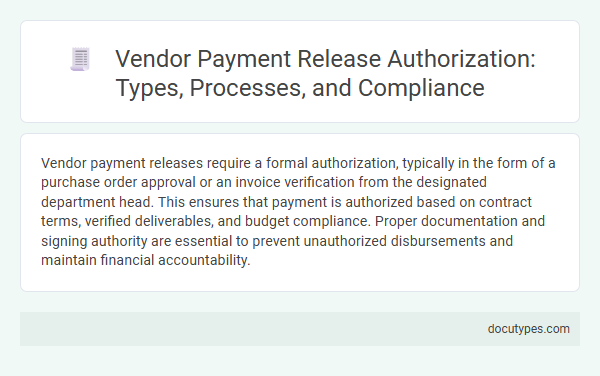Vendor payment releases require a formal authorization, typically in the form of a purchase order approval or an invoice verification from the designated department head. This ensures that payment is authorized based on contract terms, verified deliverables, and budget compliance. Proper documentation and signing authority are essential to prevent unauthorized disbursements and maintain financial accountability.
Introduction to Vendor Payment Release Authorization
Authorization for vendor payment releases ensures that payments are accurate, legitimate, and compliant with company policies. It acts as a control mechanism to prevent unauthorized transactions and financial discrepancies.
- Managerial Approval - Requires confirmation from department managers to validate the payment request aligns with budget and contractual agreements.
- Financial Controller Authorization - Involves review and authorization by the financial controller to ensure accuracy and compliance with financial regulations.
- Procurement Department Confirmation - Necessitates verification by procurement to confirm that goods or services were delivered as agreed before releasing payment.
Importance of Authorization in Vendor Payments
What type of authorization is required for vendor payment releases? Proper authorization ensures that payments are legitimate, preventing fraud and financial discrepancies. Your organization's internal controls often dictate approval levels based on payment size and vendor relationship.
Why is authorization important in vendor payments? Authorization establishes accountability and compliance with company policies and regulatory requirements. It safeguards company assets by verifying that payments are made to approved vendors under agreed terms.
Key Types of Vendor Payment Release Authorization
Vendor payment releases require specific authorization types to ensure security and compliance. Key types include managerial approval, financial controller sign-off, and automated system verification.
Managerial approval verifies the legitimacy of the payment request. Financial controller sign-off ensures budget compliance before funds are disbursed.
Manual vs Automated Authorization Processes
Vendor payment releases require proper authorization to ensure accuracy and prevent fraud. Authorization processes can be categorized as manual or automated based on workflow and system integration.
- Manual Authorization - Involves human review and approval, often through physical signatures or email confirmations.
- Automated Authorization - Utilizes software systems to verify and approve payments based on predefined rules and thresholds.
- Hybrid Authorization - Combines manual checks with automated systems to balance control and efficiency.
Choosing the appropriate authorization type depends on risk tolerance, transaction volume, and organizational controls.
Standard Operating Procedures for Payment Authorization
| Authorization Type | Description | Key Roles Involved | Standard Operating Procedures (SOP) Steps |
|---|---|---|---|
| Purchase Order Approval | Formal approval of purchase orders before vendor payments are processed. | Procurement Manager, Finance Supervisor |
1. Validate purchase order against contract terms. 2. Confirm receipt of goods or services. 3. Obtain approval signatures electronically or physically. 4. Record approval in the payment system. |
| Invoice Verification Authorization | Authorization following verification of invoices with purchase orders and delivery receipts. | Accounts Payable Officer, Department Head |
1. Match invoice details with purchase order and delivery note. 2. Check for discrepancies and resolve with vendor. 3. Approve invoice for payment release. 4. Enter authorization into financial system. |
| Payment Release Authorization | Final authorization to release payments to vendors after validation steps. | Finance Manager, CFO |
1. Review all prior approvals and documentation. 2. Confirm payment amount matches authorized invoice. 3. Approve payment batch for release. 4. Monitor payment execution and update payment records. |
| Segregation of Duties Authorization | Authorization ensuring separation between personnel handling invoice approval and payment processing to prevent fraud. | Internal Audit, Compliance Officer |
1. Define roles and responsibilities clearly. 2. Enforce access controls on payment systems. 3. Conduct periodic reviews of approval workflows. 4. Report exceptions immediately. |
Approval Workflows and Hierarchies
Authorization for vendor payment releases typically requires adherence to structured approval workflows that ensure compliance and accountability. These workflows define specific approval stages based on transaction value and organizational policies.
Hierarchies play a critical role, where different levels of management must approve payments depending on their amount or risk level. This multi-tiered authorization process minimizes errors and fraud while promoting transparency in vendor payments.
Essential Documentation and Audit Trails
Authorization for vendor payment releases requires specific approval protocols to ensure security and accuracy. Essential documentation includes purchase orders, invoices, and payment requests validated by authorized personnel.
Audit trails must capture every step of the approval process, including timestamps and approver identities, to maintain transparency. Your organization should implement digital authorization systems that log these activities automatically. Maintaining comprehensive records supports compliance with financial regulations and facilitates internal audits.
Compliance Requirements and Regulatory Standards
Authorization for vendor payment releases must align with strict compliance requirements and regulatory standards to ensure legal and financial integrity. You need to verify that all payment approvals meet these mandatory guidelines before processing.
- Internal Controls - Authorization requires adherence to company-specific internal approval workflows to prevent unauthorized disbursements.
- Regulatory Compliance - Payment releases must comply with financial regulations such as SOX, GDPR, or PCI DSS depending on jurisdiction and industry.
- Audit Trail Maintenance - All authorization steps must be documented and auditable to satisfy external and internal audit requirements.
Common Challenges and Risk Mitigation
Vendor payment releases require proper authorization to ensure financial control and compliance. Common challenges include unauthorized approvals, delayed payment processing, and weak segregation of duties. Implementing role-based access controls, automated approval workflows, and regular audit trails can effectively mitigate these risks.
What Type of Authorization Is Required for Vendor Payment Releases? Infographic

